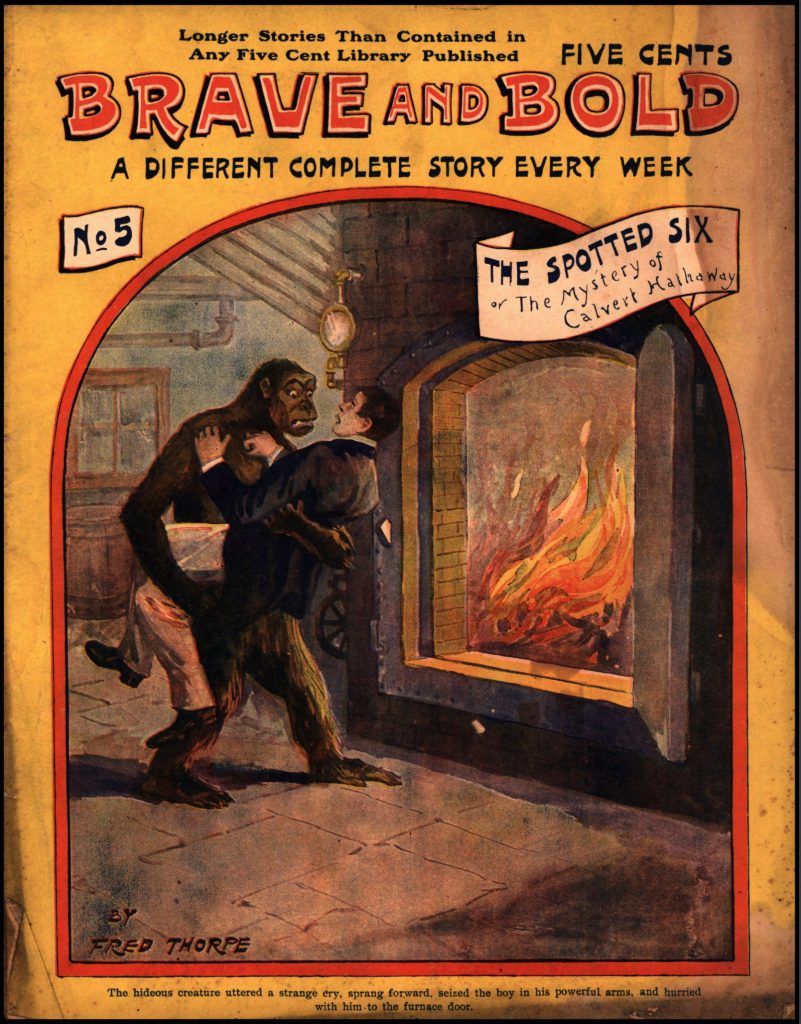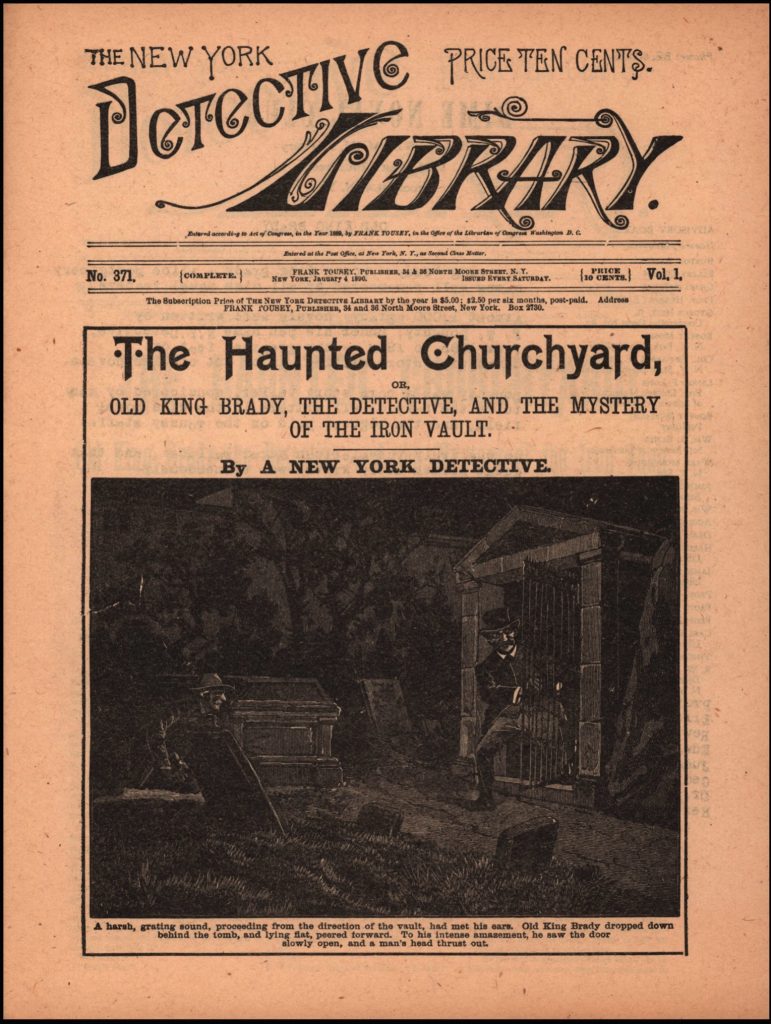Guest Post by Richard Schmidt, Digitization Coordinator in the Digital Initiatives unit
Warning: Spoilers Ahead
You can check out the entire issue from The New York Detective Library here before continuing any further.
Another Halloween is approaching stealthily through the pumpkin patch (or perhaps it’s just moseying sweatily in the 80-degree heat along USF Alumni Drive), and I’ve chosen another spooky dime novel from Special Collections here at the USF Library Tampa campus to review for your entertainment. Last time, I chose my subject purely because the cover of “The Spotted Six” was quite terrifying. You can read that very bizarre issue of Brave and Bold right here and then my review here.

For this year’s spine-tingling selection, I chose an issue based on its title alone. It’s The New York Detective Library number 371 entitled “The Haunted Churchyard, or, Old King Brady, the Detective, and the Mystery of the Iron Vault” by “A New York Detective” AKA Francis Worcester Doughty. Doughty was quite a formidable talent in his day (and an influence on the much more famous mystery and adventure writer, Edgar Wallace), having penned nearly 1,000 Old King Brady stories in just 27 years. [1]

Strangely enough, “The Haunted Churchyard” begins very similarly to “The Spotted Six” with a young man getting unfairly dismissed from his thankless job of lowly shop clerk. The young man in this story is an 18-year-old former “waif from the poorhouse” named Walter Doane. [2] A strange old man named T. Lum visits him at work and asks to meet at a particular Bostonian street corner at midnight. His terrible boss, Mr. Theophrastus Doxey, fires Walter immediately for this unexpected visitation.
While wandering the streets thinking about his sorry state of affairs and debating with himself whether he should meet up with this T. Lum, Walter witnesses a young lady on a coach struggling with the reins of its violent horse. He manages to rescue the girl and rides with her to her house so she can tell her father and see to it that Walter is properly compensated for his bravery. This lovely young woman turns out to be Kate, the daughter of his former boss Mr. Doxey! The jerk refuses to see Walter, so he bids Miss Doxey farewell and leaves. He is out the door for around two seconds when he hears a gunshot and a scream. In a darkened alley, he then hears the clatter of a pistol landing at his feet. He grabs the gun off the ground and runs back to Mr. Doxey’s house to report what he has found. When he gets there, Walter discovers Miss Kate Doxey has been shot to death.
As you may expect, Walter is accused of the crime and immediately thrown in jail. Enter Old King Brady, master detective. His job is to prove or disprove the young man’s guilt. As soon as Brady gets to work, Walter is inexplicably freed from jail when someone leaves all the doors open and distracts the guards long enough for him to slip out into the night. He then decides to keep his appointment with the cause of all this problems, Mr. T. Lum. And it is here, dear reader, that I have to stop talking about his plot in detail because this is a blog post and not the longest Wikipedia plot synopsis in history. Everything imaginable unfolds, from the ghost of a beautiful girl appearing to a killer dog, an inheritance scheme to disembodied hand, staged deaths to a hidden treasure, a drunk with an almost imperceptible (and stereotypical) German accent to an opium den, a midnight exhumation to multiple gunfights, two false imprisonments to clever disguises, and so much more.
I’m a fan of horror films, old thrillers, and all manner of whodunits, but the convoluted everything-up-to-and-including-the-kitchen-sink plot elements in “The Haunted Churchyard” were getting on my nerves by page 9. As I’ve found with dime novels from the 19th century, an entire full-length novel’s worth of plot flies by during the 32 pages. Thanks to the small print, the 32 pages of “The Haunted Churchyard’s” story is around 50,000 words. But so much happens that this one story could have been expanded and serialized for a year’s worth of issues. My jaw dropped when I discovered that this story jumps ahead a couple of years, making the ramshackle nature of plot feel even more disjointed. The story is also padded out with some truly dreadful dialogue. This possibly unintentionally funny exchange between Walter and T. Lum made me burst out laughing:
“My house?” repeated Walter, wonderingly- “my house?”
“Yes, your house.”
“I don’t understand you.”
“I know you don’t.”
“Won’t you explain yourself?”
“I’m going to.”
“I wish you would.”
“I tell you I’m going to. That’s what I brought you here for.” [3]
Luckily, the ghost shows up way more than I expected. Some dime novels will use just a bit of horror to hook a reader and then abandon it almost immediately. Doughty doubles down on the paranormal activity during the first half with a disembodied, glowing hand, the ghost of Miss Doxey in a white shroud or medieval clothing, cold spots, etc., and I loved all of it. So, dear reader, if you’re asking yourself if I’m willing to put up with a baffling, confusing story just for some ghostly thrills, you’re right! I do it all the time.
What I really enjoyed, alongside the satisfyingly spooky supernatural story elements, are the surreal and dreamlike moments that Walter experiences while hiding out in the basement of the old dark house of his ancestors. He’s nearly always running out of lamp fuel, getting disoriented in the dark or drifting off to sleep and having nightmares or the sensation of falling. There are also the strange instances of the characters feeling compelled by the spirit to do things. The ghost literally telling Walter and King Brady where to go and what to do is one thing, but there are multiple instances where they are guided along by a mysterious power. It is refreshing to me that much of the supernatural tomfoolery that befalls our characters is never explained and the author merely states at the end: “But is not the world full of such mysteries?” [4]
The time and setting of “The Haunted Churchyard” in Boston’s early spring of 1887 -while there’s still snow on the ground- also adds to the creepy, atmospheric mood. And the fact that this story often skips the daylight hours, so that we can watch the characters running around in a graveyard, a spooky old mansion, an old cellar, and secret passages in the darkness is the cherry atop this frightening sundae. Unlike my previous spooky dime novel review, I recommend “The Haunted Churchyard.” It’s a wild and silly story, but it’s never boring. Its similarity to other detective tales of its era is just fine because it does them better! And besides, the expression “Pshaw!” is exclaimed at least 4 times in 32 pages, which will endear me to just about any old-timey story.
Want to read more dime novel reviews?
- The Spotted Six or The Mystery of Calvert Hathaway
- The Liberty Boys of “76″
- Bob, the Shadow, or, Solving a Double Mystery
References
[1] Charles Bragin. Dime Novel Club Reprint, 1945.
[2] Francis Winchester Doughty, “The Haunted Churchyard, or, Old King Brady, the Detective, and the Mystery of the Iron Vault,” 1890, 3. https://digitalcommons.usf.edu/childrens_lit_books/80
[3] Francis Winchester Doughty, “The Haunted Churchyard, or, Old King Brady, the Detective, and the Mystery of the Iron Vault,” 1890, 8. https://digitalcommons.usf.edu/childrens_lit_books/80
[4] Francis Winchester Doughty, “The Haunted Churchyard, or, Old King Brady, the Detective, and the Mystery of the Iron Vault,” 1890, 30. https://digitalcommons.usf.edu/childrens_lit_books/80
Also See
“Francis W. Doughty,” Wikipedia. https://en.wikipedia.org/wiki/Francis_W._Doughty
“Series – New York Detective Library,” The Edward T. LeBlanc Memorial Dime Novel Bibliography. https://dimenovels.org/Series/630/Show